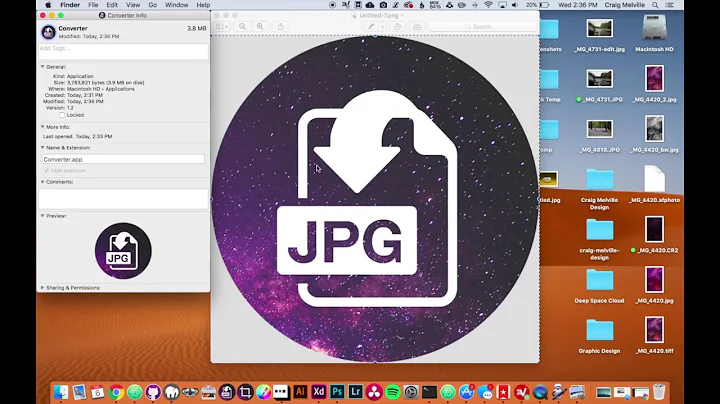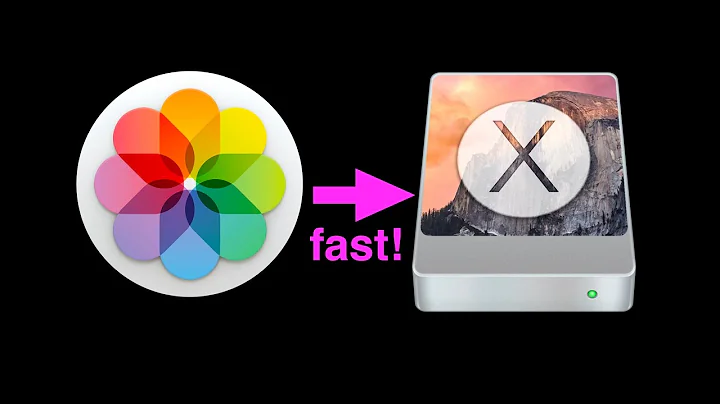Mac OS X: easiest (free, non-QuickTime Pro) application for converting numbered folder of images to movie
Solution 1
There is a freeware AppleScript-based application by the name of Sequimago which should fulfill your requirements admirably. It is available from this page at MacScripter, a forum site where Martin Michel, Sequimago's author, is an administrator.
This is his description of the program:
Requirements
Mac OS X 10.5 Leopard • QuickTime 7.2.1Installation & Usage:
Download and extract the ZIP archive. Then open the script with a double click or drop a bunch of image files onto its icon. The script will then ask you to specify a file name and location for the new QuickTime movie. After you provided certain settings for your image sequence (e.g. frames per second/seconds per frame), your image sequence will be produced.Supported Image Formats:
jpg, jpeg, gif, png, tiff, tif, psd, pict, bmp, pdf (only the first page of a PDF document is recognized)Notes:
Sequimago currently uses the JPEG image format for the image sequence, which results in a smaller file size of the QuickTime movie. But you can easily edit the Python script to use alternative image formats (e.g. TIFF). The Python script is located at: Sequimago.app/Contents/Resources/crtimgseq.py
- - - - - - - -
P.S. -- I think you'll appreciate a comment he made in the course of explaining how he came to write the program:
I knew that you could easily create custom slide shows with QuickTime Pro, but why spent hard-earned $29.99 when you can get the same functionality free of charge by using built-in Mac OS X 10.5 technologies?
Solution 2
The ffmpeg command line tool does this:
ffmpeg -n -i "image_%03d.jpg" output.m4v
ffmpeg will, in this example, look for files matching the pattern image_xxx.jpg in the current directory where the xxx part is a zero-padded decimal number, like 003. ffmpeg automatically chooses the output format based on the suffix of the output file, e.g., m4v.
Change -n to -y if you want ffmpeg to always overwrite output file without asking (useful for repeated tests).
I suggest you download ffmpeg from either homebrew or macports.
Solution 3
ImageMagick (available from macports) can do that, try running the command
convert -delay 30 'pic-*.png' movie.m4v
where 30 is the hundreths of seconds between frames and the files follow the pattern:
pic-001.png pic-002.png ...
Solution 4
ImageJ is a powerful GUI-based image editor/viewer/analyzer that, among many other things, lets you make movies from sequences of images. It meets your requirements, and provides useful options such as resizing, rotating, etc. if you want/need that.
Solution 5
For me time laps assembler does the trick. It only takes .jpg as input but I can live with that for my animation. Besides of that I just tested it and it works fine!
Related videos on Youtube
st.
C# and JavaScript developer by day; Haskell, Python, TypeScript, Cocoa, and web developer by night.
Updated on September 17, 2022Comments
-
st. almost 2 years
I'd like to convert a folder of PNGs into a quicktime .mov with PNG compression (it's a folder of fractals in an animation; PNG compression works great here and the losslessness is important). What programs will do this with minimal fuss? (I don't have or want to pay for a full license of QuickTime Pro.)
UPDATE:
Let me make this more clear: minimal fuss means: I download some EncoderMagic.app (for example), I double click it to launch it. I select the folder with my numbered images, and out pops my movie. No mess. No resizing. ... Perhaps this doesn't exist (or is called QuickTime Pro?)
-
JoeG almost 15 yearsPossibly of no interest or help to you, but I understand that 'QuickTime Pro' as we currently know and love it is going to become just 'QuickTime', fully-featured and bundled as part of Snow Leopard - in others words, included with the OS.
-
st. almost 15 yearsI used VirtualDub in Windows and accomplished my task but I'd still like to do this on my Mac if possible in the future (you know, since Macs have this reputation for being good at video and making movies). I guess I can wait for Snow Leopard?
-
-
st. almost 15 yearsUseful in theory, but 'menncoder' does not exist in the (unofficial) pre-compiled binary package. In short: No yak-shaving. I'd like to make a movie, not compile source code. (Unless that is the easiest thing out there...)
-
Tadeusz A. Kadłubowski almost 15 yearsYou can have your yaks shaven (with conditioner and a massage) by Fink or MacPorts...
-
st. almost 15 yearsNot in this case... I'm trying to turn 1000 frames into a 30 frame/sec 33.3 sec movie.
-
st. almost 15 yearsDidn't work. It made a single frame movie. (ImageMagick 6.1.8 03/22/06). I even renamed the files to pic-*.png and it still only puts the first frame.
-
st. almost 15 yearsThat did the trick. I will have to play with the encoding (png will look better for this, I think...)
-
cobbal almost 15 yearsodd, it works on mine (ImageMagick 6.5.2-9 2009-06-03)
-
Darren Young over 14 yearsI recently had to go about doing the same. Clearly the command line isn't as easy as a GUI, but once I got to know it ffmpeg let me do exactly what I wanted, no matter what I wanted to do!
-
Hans Kilian almost 13 years@Jared it's pretty old an ImageMagick you're having.. try a newer version
-
 slhck over 12 years@dan I'd suggest Homebrew over the rather old Fink. It has more updates and works just as well. Nice edit though.
slhck over 12 years@dan I'd suggest Homebrew over the rather old Fink. It has more updates and works just as well. Nice edit though. -
Dan Rosenstark about 12 years+1 great solution (except in this case)
-
shawkinaw about 11 yearsFor anyone out there trying to use this and getting a black video, try adding
-pix_fmt yuv420pimmediately before your output file name. -
deweydb over 10 yearsThis app didn't work for me. Well it worked, but i could not change the speed of the frames no matter what i put into frames per second. and when i tried seconds per frame it created a 64kb movie and then crashed.
-
Moreaki over 9 yearsFor more options (with description) check the related SU post: superuser.com/questions/356974/…
-
failedentertainment over 9 yearsSequimago still working brilliantly on OSX Mavericks...
-
Jim Bergman almost 8 yearsDon't use the
-yoption above, as it overwrites files without prompting. Use-ninstead, which halts if the output file exists. I made a mistake specifying input files, and overwrote all my source files! -
Jim Bergman almost 8 yearsIf you want to use a
*wildcard, add-pattern_type globoption before specifying input files, e.g.ffmpeg -n -pattern_type glob -i 'image*.jpg' output.mpg -
Jim Bergman almost 8 yearsFor reference, the ffmpeg docs are here: ffmpeg.org/ffmpeg.html
-
 Tomas Andrle almost 8 years@JimBergman sorry about that and thanks for the warning, I updated the answer
Tomas Andrle almost 8 years@JimBergman sorry about that and thanks for the warning, I updated the answer -
 zeeshan almost 5 yearsDoesn't work with Mojave.
zeeshan almost 5 yearsDoesn't work with Mojave.

![How to Fix QuickTime Player Can't Open MOV Files? [3 Methods]](https://i.ytimg.com/vi/dCSf7LZ00Rw/hqdefault.jpg?sqp=-oaymwEcCOADEI4CSFXyq4qpAw4IARUAAIhCGAFwAcABBg==&rs=AOn4CLBceEGAZO7VBCmGihx_AIidxDkPgg)


